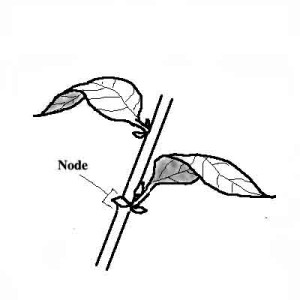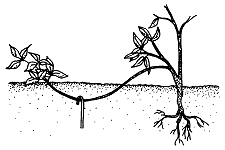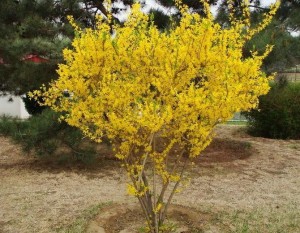Forsythia suspensa
http://www.cnseed.org/forsythia-suspensa-seeds-trifoliate-forsythia-seeds.html
Background– The Forsythia suspensa is a deciduous shrub that produces yellow/golden like flowers. With the forsythia there are many kinds of species that you can chose from, but the most common forsythia is called the weeping fig. The forsythia has four yellow/golden color petals that are narrow and the flowers trail up and down the stem. The forsythia usually flowers in the early spring to mid spring, which means they flower in March to April (Thunb, Vahl, 2007). For this shrub the hardiness zone would be in the 5-8 range. With being the the hardiness zone 5-8 the forsythia is not a good frost contender. The forsythia prefers rich soils, such as clay soils, loamy soils, and the soils need provide proper drainage as well as aeration. A good soil to use would be vermiculite because it has good ventilation and is sterile. (How-To-Propagte- Plants, 2008).
Cutting propagation
Selecting the cutting- The first step of selecting a forsythia cutting would be making sure you do not select the dead growth of the stock. You want to select the new growth of the plant that way you have a healthy cutting. The meaning of new growth means the stem does not have any flowers on it, and selecting the new years growth. With the forsythia you want to take the cuttings in June or July (Carroll,2015). While taking the cutting you want to take them in the morning because that is when the plant has the highest water and nutrient levels. You do not want to take them in the late evening because the water and nutrient levels will not be as good. A good preventive is to make sure that the cuttings and the stock are healthy is to make sure that your tools are sterilized so they do not contaminate the cutting. You also want to make sure that your hands are clean as well. For the tools you want to use 10 % alcohol cleaner.
Steps for taking the cutting-
- The first step in cutting a forsythia is you want to take a “4-6” in cutting (Carroll,2015). You want to take the cutting right below the node. The node is where the leaves emerge. Make sure when you are taking the cutting there are always 2-3 nodes on the stem.
- After taking the cutting you want to take the bottom leaves off. You want to keep the top leaves on.
- After taking the bottom leaves off you want to take to your sterilized knife cut across the plant. Cutting the plant across reduces the amount of energy the plant is using. If you cut the plant length ways, you are going to chop the cutting in half, and then you can not use that cutting. If you cut it across it will root easier.
- The next step after cutting the forsythia is dipping the cutting in a hormone. The most common hormone is Auxin. Auxin helps promotes root elongation. There are two specific types you can use which is IBA and NAA. Another one that is commonly used is Dip-N-Grow 1000ppm.
- After dipping the plant into the hormone you want to chose a soil for it. For the forsythia it likes the rich soils, like clay, loam, and vermiculite (Thunb, Vahl, 2007). When putting the cuttings into the soil you want to make sure that the soil media is wet/damp. You do not want to wet the soil to much because you do not want to over saturate it.
- After choosing the soil, you want to cover the pot. A plastic bag is the best choice because the plastic bag acts like a little green house. It keeps the moisture in (Carroll, 2015).
- After you cover them with a plastic bag you want to keep them out of direct sunlight. Putting the cuttings in a greenhouse would be best because it gets the best lighting (Carroll, 2015).
- The final step is you want to check on the plants daily. You want to make sure the soil is somewhat wet/damp but not soaking wet. You want to make sure the plants are getting good aeration. The last thing you want to check is to see if the plants have any diseases or pathogens on them and if they do the plants are no good.

The node
http://cwd.huck.psu.edu/bio414/terms.html
Watering/ roots-With watering the plants you do not want to water them right away, because you do not want to over saturate the soil because major problems can occur like root rot. The best way to water the plant is to use a mist system because it does not over saturate the soil. In about 3-6 weeks the forsythia will begin to root (Hagen, 2005). To see if they are rooting you want to give them a little tug and if the plant does not come out of the soil you know that rooting is occurring. Last but not least after two months have gone by you can take the plants out and put them in reasonably sized containers for the forsythia to grow in. Afterwards, you may transplant them to outdoors in early to mid summer.
Other propagation methods
In vitro- For in vitro propagation on the forsythia, the plant grows quickly and roots easily so there no need to do expensive and complicated process of tissue culture. In vitro will not work for the tissue culture because it has a woody stock.
Tip layering- For the forsythia ground layering/ tip layering is a very common propagation method. For ground layering what you want to do for this shrub is you want to take the leaves off of the tip of the stem. You want to wound the stem about 10 inches (Carroll, 2015). You want to make sure that the stem has a couple of nodes. You want to bury the tip in the ground and cover it with soil. The node that is buried, the roots will start to emerge from it. What you want to do is you want to have something holding it down like a nail, that way it does not stand back up on its own. You have to keep the soil moist so the roots can grow. After all of this happens you want to cut the stem with sterilized shears from the plant that its already connected to (parent plant) (Carroll, 2015).
Seed propagation- The forsythia produces a good amount of seeds but growing a forsythia from a seed can be a slow process (Carroll, 2015). With seed propagation it usually takes the forsythia seed to germinate in two months, which is a long time (Thunb, Vahl, 2007). But with the seeds you have to grow them in individual pots and you have to put them in the green house so they can survive the winter since they are not friendly with frost or cold weather (Thunb, Vahl, 2007). After this happens you can plant them in the spring and after that they should begin to root within 3-4 weeks.

Tip layering
http://assoc.garden.org/courseweb/course2/week4/page8.htm
Pot propagation- Pot layering is a lot like ground layering, but for the forsythia you have to get a pot that is big enough so the forsythia has room to grow, and you want to dig a little hole/trench in the pot. You want to make sure that the pot is cut down smoothly on both sides that way it does not cut the stem and you want to make sure the stem can lay across it also. You want to cut the stem from the plant its already attached to. You want to make sure you have something to hold it down with. From there the plant should start growing
Supplies- Right sized pots, sterilized shears, clean media, greenhouse, indoor growing conditions, Marker so you know when you took the cutting, hormones are optional.
Conclusion- There are many ways to propagate a forsythia. Some ways work faster and some ways you get better results. With seed propagation it takes longer then the cuttings because you have to wait until the seed germinates but with the seeds you do not know if you are going to have any results because the seed may not germinate or it may be a dub. The cuttings acquire a lot of work at first but after you follow the steps it gets easier. I would go with the cutting propagation because with the cuttings you can look at your plants on a daily basis to see if there is any progress being made. Also with the cutting you can tell if there are any type of diseases or pathogens that are harming the cutting. It would be easier to control because they aren’t seeds in the ground. The cuttings require less care then the other propagation practices and they are the same plant over and over again (clone). I think the stem cuttings are the way to go because you can actually produce seeds that are going to work from the original plant.
Resources-
Carroll, J. (2015, January 15). Propagating Forsythia Plants – How To Grow Forsythia From Seed And Cuttings. Retrieved October 7, 2015, from http://www.gardeningknowhow.com/ornamental/shrubs/forsythia/propagate-forsythia-shrubs.htm
How to Propagate – Tools For Propagating Plants : HGTV Gardens. (2013, February 9). Retrieved October 7, 2015, from http://www.hgtvgardens.com/garden-basics/how-to-propagate-plants?offset=1
Hagen, M. (2005, June 1). Rooting Cutttings. Retrieved October 7, 2015, from https://extension.unh.edu/resources/files/Resource000867_Rep913.pdf
ZHONG WEI Horticultural Products Company,(TOP QUALITY)Plant Seeds,Vegetables,Trees,Herbs,. (n.d.). Retrieved October 7, 2015, from http://www.cnseed.org/forsythia-suspensa-seeds-trifoliate-forsythia-seeds.html
Hartman, H. (2011). Biology of Plant propagation. In Hartman & Kester’s Plant Propagation Principles and Practies (8th ed., p. 39). Upper Saddle River, New Jersey: Pearson Education.
Vahl, Thunb. “Forsythia Suspensa.” Plants for a Future. N.p., 27 Mar. 2007. Web. 21 Oct. 2015. <http://www.pfaf.org/user/Plant.aspx?LatinName=Forsythia+suspensa>.
